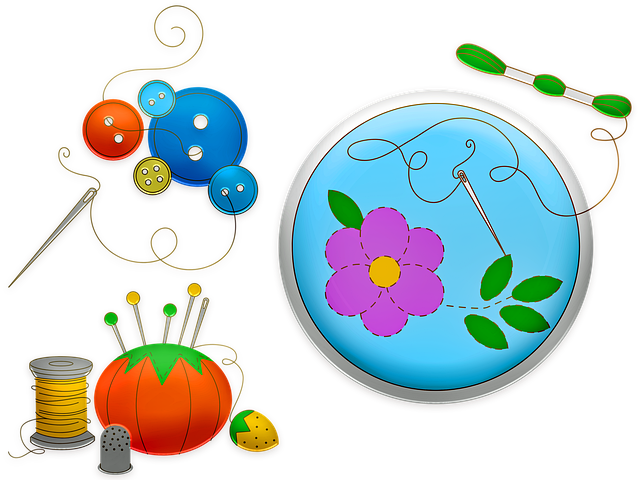Embroidery is an art that involves using needles and thread or yarn to decorate cloth or other materials. Other fabrics, such as pearls, beads, and sequins, may be incorporated into embroidery. Dres’s shirts, denim, hats, stockings, and other items commonly feature embroidery. Now because of its popularity many people are taking interest in how to start an embroidery business at home? Sound cool right!. So in clothing it comes in a variety of styles. These are the types of embroidery used in garments.

Types of Embroidery
Whitework embroidery
Well this is self-explanatory. The name alone gives away what this is all about. It’s the fine delicate embroidery done on white cloth with white thread. As seen on table linen, delicate lingerie, christening gowns, wedding veils, wedding gowns, handkerchiefs, and other products.
So, in terms of style and visual appeal, it’s the best of the best. The contrast of white stitches against white fabric is a breathtaking sight. In all work, it represents all delicate and fine.
Crazy Patchwork embroidery
Small fabric fragments are assembled on another base fabric in this technique. They are then arranged according to your preferences. And the seams are finished with decorative hand or machine stitches.
For a more dramatic effect, the applique technique is combined with decorative stitching. The beauty of mad patchwork is that you can use any stitch to embellish your pattern. It’s also used to decorate quilts.
Blackwork embroidery
Since it was originally made with black stiches on white cotton. It’s a method that’s been around for a long time. The double running stitch is the key stitch used in this technique (also called Holbein stitch).
This is a reversible product, meaning the back and front are similar. This technique produces geometric motifs that are repeated.
Tambour work /Aari work
This is a form of chain stitc technique that uses an Ari hook to create a chain stitch. It’s also known as Aari embroidery. The chain stitch is formed by the Ari hook catching the thread from the back of the fabric and forming a loop. This hook allows for fast chain stitching. The hook is also known as a Luneville hook or a tambour hook.
This work is also known as Zalakdozi in India. And it is widely used in Kashmiri goods for a beautiful sparkle, semiprecious stones, crystals. nd kundan (stones set in cast gold) are added to the work.
Crewel Embroidery
Plants, animals, and sometimes people are arranged in a fanciful, flowing pattern in this style of decorative surface embroidery. Crewel uses a number of different surface stitches. This approach has been around for at least a thousand years.
Cross-stitch Embroidery
This stitch is a hybrid stitch made up of two diagonally working stitches that form an “X” on the fabric. Count thread is a common technique.
Pulled thread Embroidery
So, counted thread technique stitches are used to create lacy bands, borders, and hems by working around groups of threads in the base fabric to form holes, airy fillings, and lacy bands, borders, and hems.
Drawn thread Embroidery
It is a form of counted thread embroidery. In which the space produced by “drawing” or removing threads from simple fabric is used to create free, airy designs. It’s often referred to as a “pulled thread job.”
Counted thread work
So, this technique creates symmetrical stitches by counting threads in the fabric for each stitch. One of the most common techniques is cross-stitch; another is blackwork.
Needle weaving
Persian openwork is another name for this technique. Drawing thread from the fabric and weaving the remaining with a thicker thread using darning or re-weaving patterns as part of this work. Decorative stitches are used to cover the exposed stiches.
Broderie Anglaise
Eyelet embroidery is another name for this technique. The fabric is cut and then stitches are made on the design lines in this openwork technique, which is close to cutwork. Satin stitches and cutwork combine to give designs a lovely open lace-like appearance.
Fish scale embroidery
Fish scales, such as goldfish or perch, are used to fill patterns in this. The fish scales were prepared, and holes were drilled in the base of each one so that it could be stitched onto the cloth.
Hardanger embroidery
It is a lovely counted technique that requires small cutwork in between satin stitch kolster blocks. To make these bricks, use pearl cotton embroided floss and sharp scissors to cut the spaces in between.
Goldwork
So, as the title suggests, this work uses metal threads in a variety of colors. Including gold, silver, and copper, to create a stunning effect.
Outline, flat, and raised designs are all made with gold thread. This stitch may be used alone or in combination with other stitches to complete a pattern.
So, If you are looking for custom embroidery patches and designs then checkout digitizing services in USA,
Was this helpful?
0 / 0